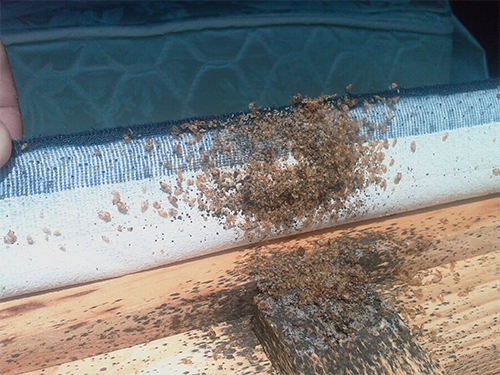Taking on Insects: What to Get out of Your Exterminator
Taking on Insects: What to Get out of Your Exterminator
Blog Article
Efficient Bed Insect Treatment Solutions for Your Home
As homeowners, coming across a bed bug problem can be an upsetting experience that calls for prompt and reliable activity - bed bug heat treatment. From identifying the first indications of a problem to figuring out one of the most appropriate therapy techniques, the procedure of removing bed pests needs focus to detail and a strategic method. In this discussion, we will explore a variety of proven solutions that can aid you resolve and get rid of bed insects from your home, providing you assurance and making sure a comfortable living setting
Recognizing the Bed Pest Problem

An additional sign of bed bugs is the presence of dark fecal spots on bed linen, furniture, or wall surfaces. These places are generally small and might hemorrhage right into the material, resembling ink stains. Moldy odors in ravaged locations can also be an indicator of bed insects, as their scent glands give off a distinctive moldy odor.
In many cases, individuals may also notice little bloodstains on sheets or pyjamas, resulting from unintentionally squashing bed bugs while sleeping. Correct recognition of these essential indications is vital for determining the presence of bed pests and starting ideal treatment measures promptly.
Non-Chemical Therapy Approaches
Upon recognizing the presence of bed pests via essential indicators such as bites, fecal places, and mildewy odors, exploring non-chemical treatment approaches comes to be crucial in properly resolving the infestation. Non-chemical approaches provide an option for people looking for eco-friendly solutions or those with level of sensitivities to typical chemicals.
Among the most efficient non-chemical approaches is heat treatment. Revealing the ravaged locations to high temperature levels can eliminate bed bugs at all life phases, consisting of eggs. This approach is non-toxic and permeates into holes where bed pests conceal. One more non-chemical alternative is vacuuming. Completely vacuuming infested surfaces, seams, and gaps can physically get rid of bed pests and their eggs. Remember to quickly throw away the vacuum cleaner bag in a secured plastic bag outside the home.
Moreover, encasing mattresses, box springs, and pillows in unique bed bug-proof covers can aid trap any bed insects inside and avoid them from feeding or getting away. Additionally, vapor therapy can be used to kill bed insects on surfaces and in materials by subjecting them to high temperature levels. Integrating these non-chemical approaches right into a detailed treatment plan can considerably boost the performance of combating bed insect invasions.
Chemical Therapy Choices
Chemical therapy alternatives are frequently used in the elimination of bed insects to properly get rid of infestations. One of the most frequently used chemicals in bed bug treatments is pyrethroids, which work by interrupting the bed pests' nervous system, eventually leading to their death.
One more efficient chemical therapy is neonicotinoids, which additionally target the nerve system of bed bugs but have shown to be more potent and have a longer residual result contrasted to pyrethroids. Desiccants, bed bug heat treatment such as diatomaceous earth, are an additional chemical treatment alternative. These compounds work by absorbing the waxy external layer of the bed pests, causing them to dehydrate and pass away.
While chemical treatments can be highly reliable in removing bed insect invasions, it is vital to follow security standards and directions supplied by specialists to lessen any kind of potential dangers to humans and family pets. - exterminator DC
Laundering and Vacuuming Methods
In enhancement to chemical therapy choices, efficient bed bug management additionally involves carrying out thorough laundering and vacuuming techniques. Washing infested things in warm water and drying them on high warm can help eliminate bed pests and their eggs. It is vital to wash and completely dry bed linen, garments, drapes, and any type of other fabric items that might have entered into call with bed pests.
Vacuuming is an additional vital technique in combating bed pest infestations. Making use of a vacuum with a solid suction power, thoroughly vacuum cleaner locations where bed bugs might conceal, such as cushions, box springs, bed frames, and carpetings. Remember to get rid of the vacuum cleaner bag in a secured plastic bag right away after vacuuming to stop bed bugs from escaping.
On a regular basis vacuuming and washing products can substantially reduce the bed insect population in your home and complement the performance of chemical treatments. By including these laundering and vacuuming approaches into your bed bug monitoring strategy, you can raise the likelihood of eliminating these bugs from your space.

Avoiding Future Infestations
Frequently examine and vacuum locations where bed bugs are recognized to conceal, such as along cushion joints, bed frames, and furnishings joints. Be vigilant when bringing pre-owned furnishings or clothes into your home, as these items can often be sources of bed bug problems. By implementing these preventative procedures, you can guard your home versus future bed pest invasions.

Final Thought
Finally, reliable bed bug therapy remedies for your home include identifying the invasion, utilizing non-chemical and chemical treatment methods, laundering and vacuuming approaches, and executing safety nets. By complying with these actions, you can properly eliminate bed bugs from your home and protect against future problems. It is very important to address the problem without delay and thoroughly to make sure a bed bug-free living environment.
Report this page